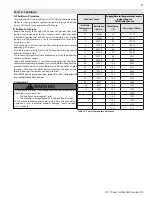
LP-719 Rev. 000 Rel. 000 Date 6.25.20
80
WARNING
!
Water drained from the boiler could be scalding hot. Wait for the
boiler to cool before draining water, and take precautions when
draining water. Failure to do so could result in property damage,
personal injury, or death.
Allowing the boiler to operate with a dirty combustion chamber
will hurt operation. Failure to clean the heat exchanger as needed
by the installation location could result in boiler failure, property
damage, personal injury, or death. Such product failures ARE NOT
covered under warranty.
The combustion chamber insulation in this product contains
ceramic fiber material. Ceramic fibers can be converted to
cristobalite in very high temperature applications. The International
Agency for Research on Cancer (IARC) has concluded, “Crystalline
silica inhaled in the form of quartz or cristobalite from occupational
sources is carcinogenic to humans (Group 1).”
• Avoid breathing dust and contact with skin and eyes.
• Use a NIOSH certified dust respirator (N95). This type of
respirator is based on the OSHA requirements for cristobalite at
the time this document was written. Other types of respirators
may be needed depending on job site conditions. Current
NIOSH recommendations can be found on the NIOSH website:
http://www.cdc.gov/niosh/homepage.html. NIOSH approved
respirators, manufacturers, and phone numbers are also listed
on this website.
• Wear long-sleeved, loose fitting clothing, gloves, and eye
protection.
• Apply enough water to the combustion chamber lining to
prevent dust.
• Wash potentially contaminated clothes separately from other
clothing. Rinse clothes washer thoroughly.
NIOSH stated First Aid.
• Eye: Irrigate immediately.
• Breathing: Fresh air.
Cleaning the Heat Exchanger Combustion Chamber
*Before beginning this procedure, have on hand the following items:
• a nylon or other non-metallic brush
• an FDA approved liquid lime scale remover in a spray bottle
• gloves and eye protection
1. Remove the silencer.
Figure 77 - Remove the silencer
2. Unscrew the two (2) nuts and remove the gas pipe.
Figure 78 - Remove the gas pipe
Figure 79 - Remove the Blower and Electrodes
Figure 80 - Remove the Combustion Assembly 1
3. Remove the gas diaphragm (if present).
4. Disconnect the electrical connections from the electrodes,
igniter, and blower.
5. Unscrew the four (4) nuts on the burner door and remove it.
6. Check the back wall insulation and replace if necessary.
7. Disconnect the condensate hose and siphon cap from the
boiler.










































